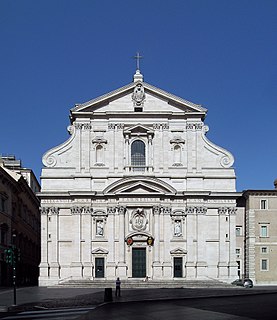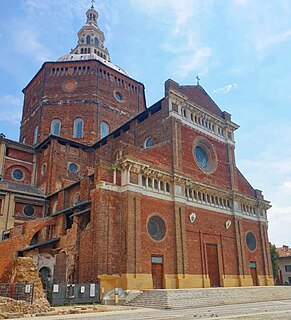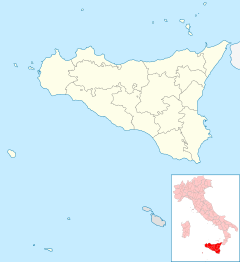
The Church of the Gesù is the mother church of the Society of Jesus (Jesuits), a Catholic religious order. Officially named Chiesa del Santissimo Nome di Gesù all'Argentina, its facade is "the first truly baroque façade", introducing the baroque style into architecture. The church served as a model for innumerable Jesuit churches all over the world, especially in the Americas. Its paintings in the nave, crossing, and side chapels became models for Jesuit churches throughout Italy and Europe, as well as those of other orders. The Church of the Gesù is located in the Piazza del Gesù in Rome.

St John's Co-Cathedral is a Roman Catholic co-cathedral in Valletta, Malta, dedicated to Saint John the Baptist. It was built by the Order of St. John between 1572 and 1577, having been commissioned by Grand Master Jean de la Cassière as the Conventual Church of Saint John.

The Basilica of San Domenico is one of the major churches in Bologna, Italy. The remains of Saint Dominic, founder of the Order of Preachers (Dominicans), are buried inside the exquisite shrine Arca di San Domenico, made by Nicola Pisano and his workshop, Arnolfo di Cambio and with later additions by Niccolò dell'Arca and the young Michelangelo.

The Dominican Church, also known as the Church of St. Maria Rotunda, is an early Baroque parish church and minor basilica in the historic center of Vienna, Austria. It is the third church built on the same site in the course of time.

Pisa Cathedral is a medieval Roman Catholic cathedral dedicated to the Assumption of the Virgin Mary, in the Piazza dei Miracoli in Pisa, Italy, the oldest of the three structures in the plaza followed by the Pisa Baptistry and the Campanile known as the Leaning Tower of Pisa. The cathedral is a notable example of Romanesque architecture, in particular the style known as Pisan Romanesque. Consecrated in 1118, it is the seat of the Archbishop of Pisa. Construction began in 1063 and was completed in 1092. Additional enlargements and a new facade were built in the 12th century and the roof was replaced after damage from a fire in 1595.

Giacomo Serpotta was an Italian sculptor, active in a Rococo style and mainly working in stucco.

San Silvestro al Quirinale is a historic church in central Rome, Italy. It is located near Via XXIV Maggio corner with Via Mazzarino, a few blocks south of the Piazza del Quirinale.

San Francesco della Vigna is a Roman Catholic church in the Sestiere of Castello in Venice, northern Italy.

Pavia Cathedral is a church in Pavia, Italy, the largest in the city and seat of the Diocese of Pavia. The construction was begun in the 15th century on the site of two pre-existing Romanesque, "twin" cathedrals. The cathedral houses the remains of St. Sirus, first Bishop of Pavia, and a thorn purported to be from the Crown of Thorns worn by Christ. The marble facing of the exterior was never completed.

The Church of SS. Claudius and Andrew of the Burgundians is a Roman Catholic church dedicated to Saint Claudius of Besançon and the apostle Saint Andrew. It is one of the national churches in Rome dedicated to France. Built from 1728 to 1730, the church was designed by French architect Antoine Dérizet.

Civita Castellana Cathedral is a cathedral in Civita Castellana, central Italy. It is the episcopal seat of the Diocese of Civita Castellana.

The Church of the Gesù, known also as the Saint Mary of Jesus or the Casa Professa, is a Baroque-style, Roman Catholic church established under the patronage of the Jesuit order, and located at Piazza Casa Professa 21 in Palermo, region of Sicily, Italy.

Volterra Cathedral is a Roman Catholic cathedral in Volterra, Italy, dedicated to the Assumption of the Virgin Mary. It is the seat of the bishop of Volterra.

Santa Sofia is a Roman catholic church located in the Piazza of Anacapri, on the island of Capri, Italy. It dates to 1596 when it replaced Chiesa di Santa Maria di Costantinopoli as the parish church. Some of the building materials and fittings, such as the sacristy and oratorio, were originally in the Chiesa di San Carlo. The church chapels are dedicated to Sant'Antonio, Anacapri's patron saint, and the Madonna del Buon Consiglio. Architectural features include two bell towers and a baroque facade. The wedding of Guiliana DePandi and Bill Rancic occurred at the Chiesa di Santa Sofia.

The Basilica of San Giovanni Maggiore is a church in Largo San Giovanni Maggiore in central Naples, Italy.

Santa Caterina d'Alessandria or Saint Catherine of Alexandria is a Roman Catholic church with a main facade on Piazza Bellini, and a lateral Western facade facing the elaborate Fontana Pretoria, in the historic quarter of Kalsa in the city of Palermo, region of Sicily, Italy. In front of the main facade, across the piazza Bellini, rise the older churches of San Cataldo and Santa Maria dell'Ammiraglio, while across Piazza Pretoria is the Theatine church of San Giuseppe and the entrance to the Quattro Canti. Refurbished over the centuries, the church retains elements and decorations from the Renaissance, Baroque, and late-Baroque (Rococo) eras. This church is distinct from the Oratorio di Santa Caterina found in the Olivella neighborhood.

The Church of Saint Ignatius is a Baroque church of Palermo. It is located in the ancient neighborhood of the Olivella, in the quarter of the Loggia, within the historic centre of Palermo.

The Parish Church of the Assumption of the Blessed Virgin Mary into Heaven is a Roman Catholic parish church in Żebbuġ, Gozo, Malta, dedicated to the Assumption of Mary. The present building was built between 1690 and 1726 on the site of an earlier church, and it was enlarged between 1938 and 1942. The church's interior was extensively decorated using locally-sourced travertine from cave deposits in the late 20th century.
The Oratorio del Rosario di Santa Cita is a Baroque chapel or prayer room located in the quarter of the Castellamare within the historic center of Palermo, region of Sicily, Italy. The site is best known for the remarkable stucco tableux scenes composed during 1687-1718 by Giacomo Serpotta.

The Madonna of the Rosary is an altarpiece painted in oil by Italian artist Carlo Maratta, located in the Oratory of San Cita for which it was painted, in Palermo, region of Sicily, Italy.






















